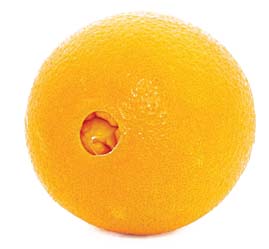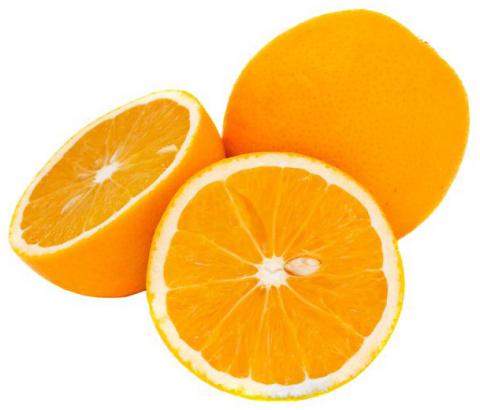Navels vs. Valencias
- By Julie Collins
- Last Updated On
- Reading Time: 3 mins.
 Navel oranges (the “winter” orange) and Valencia oranges (the “summer” orange) are similar in flavor and appearance, but what distinguishes one from the other?
Navel oranges (the “winter” orange) and Valencia oranges (the “summer” orange) are similar in flavor and appearance, but what distinguishes one from the other?
Oranges are one of the most commonly grown fruits in the world, and both Valencias and navels are categorized as sweet oranges of the genus Citrus x sinensis. From the outside, the characteristic that can help you tell them apart most easily is the feature that gives navel oranges their name: the navel! (Valencias don’t have one.)
The Navel Orange
The navel orange actually grows a second “twin” fruit opposite its stem. The second fruit remains underdeveloped, but from the outside, it resembles a human navel—hence the name. Navels are part of the winter citrus family. They’re seedless, peel easily, and are thought to be one of the world’s best-tasting oranges.
Get Fresh Fruit Delivered to Your Home!
Skip the grocery store and let us bring the farmers market to you.The Valencia Orange
 The Valencia orange (typically available starting in March and continuing through September or so) is named for the city of Valencia in Spain, although its actual origins are unknown. Valued for their high juice content and availability outside of the typical citrus season, Valencia oranges are usually thin-skinned and have a few seeds. They are considered one of the best oranges for juicing.
The Valencia orange (typically available starting in March and continuing through September or so) is named for the city of Valencia in Spain, although its actual origins are unknown. Valued for their high juice content and availability outside of the typical citrus season, Valencia oranges are usually thin-skinned and have a few seeds. They are considered one of the best oranges for juicing.
A medium orange of any variety has only about 60 calories and provides 116% of the daily value of vitamin C; 13% of dietary fiber; 10% folate; 8% thiamin; 7% potassium; 6% vitamin A; and 5% calcium. This makes them a great snack for any time of day.
It’s Easy Being Green!
Don’t be deterred if you see a tinge of green on Valencia oranges—it doesn’t mean that the fruit is unripe. Because Valencia oranges grow in the warmer seasons, they’re exposed to more sunlight, which can trigger the production of chlorophyll in the peel to help protect the fruit from sunburn. The process is called “regreening.”
Green-tinged oranges are ripe and still taste sweet! In fact, Emily Ayala of Friend’s Ranch in Ojai, CA, growers of the fabulous Pixie tangerine and other citrus, told The FruitGuys that “some of our data shows green citrus has more sugar than the deep-orange fruit.”
Sweet and Neat
The aroma, juiciness, and sweetness of an orange can be the perfect afternoon pick-me-up at the office. But there are some of us who don’t eat oranges at our desk because we’re afraid of spraying juice everywhere. Fear not! There are solutions.
1. The Score:
Using a sharp or serrated knife, trim off the top and bottom of your orange peel, then score the orange peel vertically from top to bottom in several places, being careful not to cut into the fruit. Remove each strip of peel, then gently split your orange into sections to enjoy.
2. The Wedge:
Using a sharp or serrated knife, trim off the top and bottom of your orange peel, then slice the orange in half from top to bottom. Place halved oranges on the cutting board, slice each half into three or four wedges, then eat the orange out of the peel.
3. The Roll:
If you don’t have access to a knife, you can loosen the skin of the orange by rolling it firmly on your desk for 20–30 seconds. To start peeling, gently puncture the skin with your thumbnail near the top or bottom of the orange.
Recent Articles
All About the Australian Finger Lime
Which Plums Are the Sweetest? Top Picks from the Pros
How to Keep Bananas Fresh In the Summer (Expert Tips!)
Subscribe to our Newsletter
"*" indicates required fields





